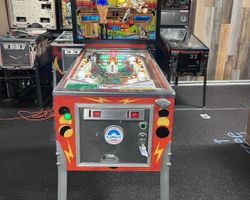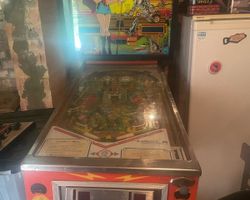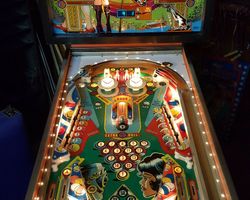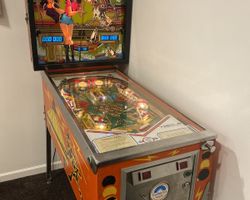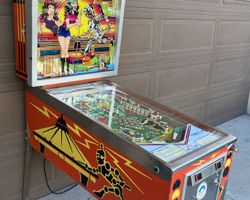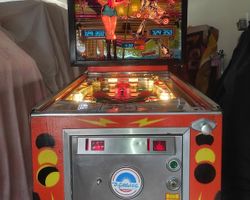Pinball Pool
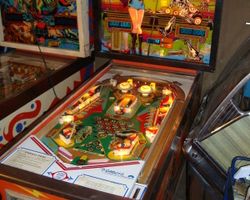
Average Prices: USD $200 to $1,000
Produced: June, 1979
Production Run: 7,200 units
Machine Type: Solid State Electronic
MPU: Gottlieb System 1
Players: 4
Design by: Ed Krynski
Art by: Gordon Morison
"Pinball Pool" by D. Gottlieb & Co. emerges from the late 1970s, a solid-state electronic pinball machine released in June 1979. This particular machine, model number 427, saw a production run of 7,200 units, indicating Gottlieb's confidence in its appeal. During an era when pinball was rapidly transitioning from electro-mechanical (EM) systems to more sophisticated solid-state (SS) electronics, "Pinball Pool" represents Gottlieb's contribution to this evolving landscape, built on their System 1 platform.
The machine's theme is a direct nod to the classic game of billiards, yet it introduces an unexpected layer with retro sci-fi and robotic elements, a unique blend that Gottlieb highlighted with the marketing slogan, "Pinball Pool makes the combination." The creative vision behind "Pinball Pool" was a collaborative effort, with Ed Krynski overseeing the game design and Gordon Morison crafting the distinctive artwork. Krynski was a seasoned designer for Gottlieb, known for creating layouts that often emphasized satisfying shots and approachable gameplay. Morison's artistic contributions, especially his backglass renditions, frequently provided a vivid visual identity for Gottlieb's machines. A curious piece of trivia related to "Pinball Pool" is its appearance in pop culture, specifically in the second season, seventh episode, titled "Mike Fright," of the television sitcom WKRP in Cincinnati. This brief screen time offers a glimpse into the machine's presence in arcades and public spaces during its original release period.
"Pinball Pool" distinguishes itself through a suite of features that define its gameplay and aesthetic. Central to its identity is the artwork, particularly the backglass, which frequently garners praise for its vibrant colors and striking mirror finish. Gordon Morison’s art on the backglass successfully blends the billiards theme with futuristic imagery, featuring a pool table alongside a robotic character and human figures, creating a cohesive visual narrative. While widely acclaimed for its beauty, this artwork also drew a differing opinion from one observer who found it unappealing.
A standout mechanical innovation on "Pinball Pool" is its "Remotrip" drop targets. The machine features two banks of seven drop targets each. The unique "Remotrip" mechanism means that hitting a target in one bank causes the corresponding target in the opposing bank to drop simultaneously. This mechanic is a core differentiator, ensuring that clearing targets is not merely a sequential task but a dynamic interaction across the playfield, encouraging players to engage with both sides of the game. Another key element is the captive ball, visually represented as the 8-ball, positioned centrally on the playfield. This captive ball is integral to achieving specific game objectives, providing a tangible focus for players aiming for high scores or extra balls. The sound system, a common characteristic of Gottlieb System 1 machines from this period, offers basic tones and effects. While fitting for its era and sometimes described as less intrusive than some modern sound packages, its simplicity and lack of complexity, often compared to the sounds of early video games like "Pong," are frequently noted by players. This simplicity, however, does not detract from the machine's inherent playability.
The playfield of "Pinball Pool" is laid out to support a focused, target-oriented game flow. It features two flippers at the base, two pop bumpers, and two slingshots that contribute to ball movement and scoring opportunities. The machine also incorporates two kick-out holes, which are important for advancing bonus multipliers and setting up further playfield action. The defining characteristic of the playfield is the prevalence of its 14 drop targets, arranged in two distinct banks of seven. These are not merely obstacles but the primary scoring and progression mechanism, especially with the unique "Remotrip" feature ensuring constant interaction. The single captive ball, centrally located, serves as a crucial target for specific objectives, demanding precision for successful shots. Upper rollover lanes also contribute to bonus progression.
The design philosophy behind "Pinball Pool" centers on accessible yet engaging gameplay. The flow encourages players to aim for the drop targets, methodically clearing them to light various features and accumulate points. Shots to the captive ball are designed to be controllable for skilled players, though wild shots can lead to quick drains, adding an element of risk-reward. Utilizing the upper rollover lanes and kick-out holes is essential for building the bonus multiplier, a key strategy for maximizing overall scores. The artwork on the playfield is vibrant and clear, reinforcing the pool theme and guiding the player's eye towards important targets and scoring zones. While the machine's overall aesthetic is strong, some aspects of its mechanical setup, such as a potentially wide flipper gap and certain shots leading directly to center drains, can make gameplay challenging, often mitigated by adjusting the machine's back leg angle to increase playfield speed and reduce drain frequency.
"Pinball Pool" offers a straightforward yet engaging gameplay dynamic that keeps players returning for "just one more game." The core objective revolves around systematically clearing the numerous drop targets, which, due to the "Remotrip" feature, resets after each ball, ensuring continuous challenge and satisfaction. The scoring system, capable of displaying up to 999,990 points per player, places a strong emphasis on the bonus multiplier. Advancing this multiplier is crucial for achieving high scores and is accomplished by hitting specific targets, rolling through upper lanes, or sending the ball into the kick-out holes.
Beyond raw points, the game offers distinct objectives. Hitting the captive ball, representing the 8-ball, multiple times is the path to earning an extra ball, a coveted reward that extends playtime and scoring potential. While the rules are generally simple and easy for new players to grasp, there is underlying strategic depth for experienced players focused on score maximization. Successful strategies involve careful aiming at the drop targets, calculating controlled shots to the captive ball, and skillfully utilizing the upper playfield elements to build up the bonus multiplier. Despite its simplicity, "Pinball Pool" provides satisfying shot feedback and a clear progression path, contributing to its addictive quality.
"Pinball Pool" has generally been met with a positive reception within the pinball community, often described as a fun, addictive, and satisfying game that strikes a balance between simplicity and strategic depth. Its strengths are often cited as its engaging drop target mechanics, particularly the "Remotrip" feature which provides unique playfield interaction, and its well-executed pool theme. The artwork, especially the backglass, frequently draws praise for its vibrant appeal, with many considering it a visually attractive machine that stands out from its contemporaries. The game's accessible rules make it approachable for new players while offering enough underlying strategy through bonus multipliers and the captive ball objective to keep experienced players engaged. It is often regarded as a suitable machine for multiplayer sessions, fostering friendly competition due to its clear objectives. Many owners express a desire to keep "Pinball Pool" in their collections long-term, highlighting its enduring appeal and "just one more game" quality.
However, the machine is not without its noted weaknesses. The most consistent critique revolves around its basic sound system, which is described as weak or "like pong," lacking the melodic chimes or complex audio cues found in some other machines of the era. While some find this acceptable for the period, many wish for a more advanced sound package. Gameplay speed is also a point of discussion; while some find it fast and challenging, particularly when set at a steeper playfield angle, others describe it as slow or even "stale," suggesting that proper machine setup is crucial for optimal play. The wider flipper gap and certain drain-prone shots, especially to the center drop target or captive ball, are also noted as areas that can lead to shorter ball times, though adjusting outlane posts can sometimes alleviate this.
In the broader context of pinball history, "Pinball Pool" holds a respectable position as a well-regarded Gottlieb System 1 title. It is often grouped with other successful Gottlieb solid-state machines from this period, such as "Close Encounters" and "Joker Poker," as examples of the manufacturer's design approach during the transition from electro-mechanical games. While some contemporary titles from manufacturers like Bally and Williams might be seen by some as offering more complex rule sets or faster play, "Pinball Pool" carved its niche through its unique "Remotrip" target innovation and its satisfying, direct gameplay. Its straightforward appeal to a wide range of players ensures its continued relevance and reputation as a classic example of Gottlieb's solid-state era.
Sponsored Links
 Ebay Listings
Ebay Listings
 Auction Results
Auction Results
| Cost | Location | Date |
|---|---|---|
| USD $3,889 |  Florida, United States Florida, United States |
27 April, 2025 |
| USD $1,400 |  Michigan, United States Michigan, United States |
02 September, 2024 |
| GBP £735 |  United Kingdom United Kingdom |
17 July, 2023 |
| USD $2,900 |  Florida, United States Florida, United States |
14 November, 2022 |
| EUR €2,210 |  Baden-Württemberg, Germany Baden-Württemberg, Germany |
07 November, 2022 |
| USD $1,600 |  United States United States |
23 October, 2022 |
| USD $2,000 |  California, United States California, United States |
13 October, 2022 |
| EUR €1,500 |  Nordrhein-Westfalen, Germany Nordrhein-Westfalen, Germany |
06 February, 2022 |
| USD $2,500 |  New York, United States New York, United States |
09 November, 2021 |
| USD $2,500 |  New York, United States New York, United States |
06 October, 2021 |


Private Policy · Search Website · Contact Us
As an eBay Partner, we may earn a commission from qualifying purchases made through links on this site, at no additional cost to you.
All trademarks and copyrighted materials remain property of their respective owners. All other content copyright 2007 - 2025 Pinpedia.

